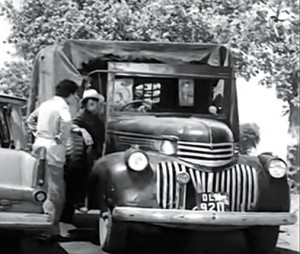Devanand and Kalpana Kartik may have played a lead role in the 1957 Hindi movie Nau Do Gyarah, it is the Chevrolet truck that drove the duo to perform. Looked upon as one of the most enjoyable classics to this day, the movie was released in 1958. It began with a scene where Devanand is thrown out of the house for not paying the rent. The plot, evolving around a simple theme of Devanand’s uncle urging him to travel to Mumbai and inherit his wealth, includes Devanand’s visit to his friend who has been collecting his mails. Among the mails is a letter from Devanand’s uncle, which states that he should come and inherit his wealth worth Rs.11 lakh, and a property worth Rs.2 lakh. Devanand’s uncle, in his will, had marked his wealth and property to his sister-in-law’s son. Upon learning that he is not a good person, he wrote the letter to Devanand.
To travel to Mumbai from Delhi, Devanand selects a beat-up Chevrolet truck from among a display of vehicles at a showroom. On the way, a friend drags Devanand to a wedding. Devanand expresses to his friend that he would have run away if he were the bride. He feels that the groom is not a good person. Devanand’s expression finds way to the bride played by Kalpana Kartik. She hides in Devanand’s truck by disguising herself as a Sikh boy with a pseudonym of Sardar Nihal Singh. During the course of the journey Devenand accidentally discovers that there’s someone else in the truck, albeit hiding away at the rear. Compelled to let the Sardar ride with him is the amount of money, food and water ‘he’ is carrying. The two quarrel almost continuously, and the disguise does not hold for long. Sardar Nihal Singh turns out to be the girl Devanand saw at the wedding. Devanand falls in love with the girl. The girl too falls in love with Devanand. A love story unfurls with the Chevrolet truck playing a strong, silent role in the movie. It also forms the basis for the famous song, ‘Hum Hai Rahi Pyar ke’.
The Chevrolet truck that Devanand pilots is a PV model that was built between 1941 and 1948. Over the one before, this one flaunted a complete style change when it was launched in 1941. The most striking change was at the front. The parking light assembly was placed on the top of the headlight bracket. The headlight was placed on the fender. The RHD PV Devanand drove is said to have been assembled in India at General Motor’s assembly operation at Sewree in Mumbai. It was in 1939 that Chevrolet set up an assembly operation in India. The trucks, like this 1-tonne model, were assembled from Canadian chassis and locally fabricated bodies. As is the case with this truck, most came with a soft top. The cargo deck also featured a soft top supported by a structure of rods that could be dismantled. While this particular truck may have been built in the mid or late 40s, power came from a 4-litre in-line six-cylinder petrol engine. Transmission was a four-speed, manual unit. Behind the large diameter three spoke steering wheel was situated an instrument panel in the form of a rectangular case. It was embedded into a simple metal dash.




















